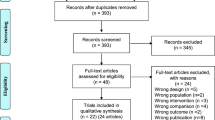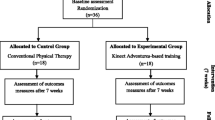Abstract
Introduction
Parkinson’s disease (PD) is a neurodegenerative pathology characterized by motor and non-motor symptoms that often lead to several impairments. Many studies show the efficacy of different rehabilitation protocols aimed to improve balance and gait functions in PD patients. However, multiple factors may influence rehabilitation outcome. Recently, it has been observed as the cognitive reserve (CR) may influence the rehabilitation outcome, helping to address the patient toward technological or conventional rehabilitation. Our study investigated how CR may affect motor rehabilitation outcomes in PD patients who undergo virtual reality (VR) rehabilitation, aimed at improving walking and balance.
Materials and methods
Thirty patients affected by idiopathic PD were enrolled. Patients underwent 12 sessions VR training, over 6 weeks (45 min). Six-Minute Walk Test (6MWT) and Berg Balance Scale (BBS) were used to assess walking and balance, respectively. CR was assessed by Cognitive Reserve Index questionnaire (CRIq).
Results
Significant correlations between CR and change from baseline in walking and balance measures were found, with a significant positive correlation between CRIq and 6MWT (r=0.50, p=0.01) and between CRIq and BBS (r=0.41, p=0.04).
Discussion
Our results showed that PD patients with higher CR treated with VR improved significantly more in their balance and walking distance than those with lower CR. The current study suggests that VR when aimed to improve balance and walking in PD patients is more effective in patients with higher CR.




Similar content being viewed by others
References
Mak MK, Wong-Yu IS, Shen X, Chung CL (2017) Long-term effects of exercise and physical therapy in people with Parkinson disease. Nat Rev Neurol 13:689–703
Shen X, Wong-Yu IS, Mak MK (2016) Effects of exercise on falls, balance, and gait ability in Parkinson’s disease: a meta-analysis. Neurorehabil Neural Repair 30:512–527
Collomb-Clerc A, Welter ML (2015) Effects of deep brain stimulation on balance and gait in patients with Parkinson’s disease: a systematic neurophysiological review. Neurophysiol Clin 45:371–388
Hackney ME, Earhart GM (2009) Health-related quality of life and alternative forms of exercise in Parkinson disease. Parkinsonism Relat Disord 15:644–648
Vetrano DL, Villani ER, Grande G, Giovannini S, Cipriani MC, Manes-Gravina E, Bernabei R, onder G (2018) Association of polypharmacy with 1-year trajectories of cognitive and physical function in nursing home residents: results from a multicenter European Study. J Am Med Dir Assoc 19:710–713
Giovannini S, van der Roest HGHG, Carfì A et al (2018) Polypharmacy in home care in Europe: cross-sectional data from the IBenC study. Drugs Aging 35:145–152
Tomlinson CL, Patel S, Meek C et al (2012) Physiotherapy versus placebo or no intervention in Parkinson’s disease. Cochrane Database Syst Rev 11:CD002817
Ahlskog JE (2011) Does vigorous exercise have a neuroprotective effect in Parkinson disease? Neurology 77:288–294
Kurt EE, Büyükturan B, Büyükturan Ö, Erdem HR, Tuncay F (2018) Effects of Ai Chi on balance, quality of life, functional mobility, and motor impairment in patients with Parkinson’s disease. Disabil Rehabil 40:791–797
Sturkenboom IH, Nijhuis-van der Sanden MW, Graff MJ (2016) A process evaluation of a home-based occupational therapy intervention for Parkinson’s patients and their caregivers performed alongside a randomized controlled trial. Clin Rehabil 30:1186–1199
Song R, Grabowska W, Park M, Osypiuk K, Vergara-Diaz GP, Bonato P, Hausdorff JM, Fox M, Sudarsky LR, Macklin E, Wayne PM (2017) The impact of Tai Chi and Qigong mind-body exercises on motor and non-motor function and quality of life in Parkinson’s disease: a systematic review and meta-analysis. Parkinsonism Relat Disord 41:3–13
Wang B, Shen M, Wang YX, He ZW, Chi SQ, Yang ZH (2019) Effect of virtual reality on balance and gait ability in patients with Parkinson’s disease: a systematic review and meta-analysis. Clin Rehabil 33:1130–1138. https://doi.org/10.1177/0269215519843174
Lina C, Guoen C, Huidan W, Yingqing W, Ying C, Xiaochun C, Qinyong Y (2020) The effect of virtual reality on the ability to perform activities of daily living, balance during gait and motor function in Parkinson’s disease patients-- a systematic review and meta-analysis. Am J Phys Med Rehabil 99:917–924. https://doi.org/10.1097/PHM.0000000000001447
Pazzaglia C, Imbimbo I, Tranchita E, Minganti C, Ricciardi D, Lo Monaco R, Parisi A, Padua L (2020) Comparison of virtual reality rehabilitation and conventional rehabilitation in Parkinson’s disease: a randomised controlled trial. Physiother (United Kingdom) 106:36–42. https://doi.org/10.1016/j.physio.2019.12.007
Vetrano DL, Collamati A, Magnavita N, Sowa A, Topinkova E, Finne-Soveri H, van der Roest HG, Tobiasz-Adamczyk B, Giovannini S, Ricciardi W, Bernabei R, onder G, Poscia A (2018) Health determinants and survival in nursing home residents in Europe: results from the SHELTER study. Maturitas 107:19–25
Fortune DG, Walsh RS, Richards HL (2016) Cognitive reserve and preinjury educational attainment: effects on outcome of community-based rehabilitation for longer-term individuals with acquired brain injury. Int J Rehabil Res 39:234–239
Stern Y (2009) Cognitive reserve. Neuropsychologia 7:2015–2028
Stern Y (2002) What is cognitive reserve? Theory of research application of the reserve concept. J Int Neuropsychol Soc 8:448–460
Koerts J, Tucha L, Lange KW, Tucha O (2013) The influence of cognitive reserve on cognition in Parkinson’s disease. J Neural Transm 120:593–596
Perneczky R, Drzezga A, Boecker H, Ceballos-Baumann AO, Granert O, Förstl H, Kurz A, Häussermann P (2008) Activities of daily living, cerebral glucose metabolism, and cognitive reserve in Lewy body and Parkinson’s disease. Dement Geriatr Cogn Disord 26:475–481
Hindle JV, Martyr A, Clare L (2014) Cognitive reserve in Parkinson’s disease: a systematic review and meta-analysis. Parkinsonism Relat Disord 20:1–7
Piccinini G, Imbimbo I, Ricciardi D, Coraci D, Santilli C, Lo Monaco MR, Loreti C, Vulpiani MC, Silveri MC, Padua L (2018) The impact of cognitive reserve on the effectiveness of balance rehabilitation in Parkinson’s disease. Eur J Phys Rehabil Med 54:554–559
Padua L, Imbimbo I, Aprile I, Loreti C, Germanotta M, Coraci D, Piccinini G, Pazzaglia C, Santilli C, Cruciani A, Carrozza MC, the FDG Robotic Rehabilitation Group, Pecchioli C, Loreti S, Lattanzi S, Cortellini L, Papadopoulou D, Liberti G, Panzera F, Mitrione P, Ruzzi D, Rinaldi G, Insalaco S, de Santis F, Spinelli P, Marsan S, Bastoni I, Pellegrino A, Petitti T, Montesano A, Castagna A, Grosso C, Ammenti P, Cattaneo D, Azzinnaro L, Barbieri D, Cassani S, Corrini C, Meotti M, Parelli R, Spedicato A, Zocchi M, Loffi M, Manenti D, Negri L, Gramatica F, Gower V, Galeri S, Noro F, Medici L, Garattini R, Bariselli F, Luli M, Ricca M, Negrini S, Diverio M, Giannini E, Gabrielli A, Deidda B, Gnetti B, Beatini P, Callegari S, Cabano B, Converti F, Pizzi A, Falsini C, Romanelli A, de Luca G, Vannetti F, Simoncini E, Martini M, Peccini E, Cecchi F, Avila L, Gabrielli MA, Barilli M, Bertocchi E, Giannarelli G, Lerda E, Vasoli M, Rossi P, Marsili V, Tognoli B, Bertolini A, Vastola G, Speranza G, Colella M, Mosca R, Competiello G, Chiusano A, Della Vecchia A, Soriano P, Pagliarulo M, Remollino V, Langone E, Santarsiero R, Magliulo M, Araneo G, Galantucci L, Lioi N, Marrazzo F, Larocca S, Calia R, Benevento S, Toscano O, Lategana M (2020) Cognitive reserve as a useful variable to address robotic or conventional upper limb rehabilitation treatment after stroke: a multicentre study of the Fondazione Don Carlo Gnocchi. Eur J Neurol 27:392–398. https://doi.org/10.1111/ene.14090
Hoehn MM, Yahr MD (1967) Parkinsonism: onset, progression, and mortality. Neurology 17:427–442. https://doi.org/10.1212/wnl.17.5.427
Magni E, Binetti G, Bianchetti A, Rozzini R, Trabucchi M (1996) Mini-mental state examination: a normative study in Italian elderly population. Eur J Neurol 3:198–202
Nucci M, Mapelli D, Mondini S (2012) Cognitive Reserve Index questionnaire (CRIq): a new instrument for measuring cognitive reserve. Aging Clin Exp Res 24:218–226
Antonini A, Abbruzzese G, Ferini-Strambi L et al (2013) Validation of the Italian version of the Movement Disorder Society--Unified Parkinson’s Disease Rating Scale. Neurol Sci 34:683–687
All H, Issues A, Nov N et al (2013) ATS statement: guidelines for the six-minute walk test. Am J Respir Crit Care Med 284:111–117. https://doi.org/10.1164/rccm.166/1/111
Vanhoutte EK, Faber CG, Van Nes SI et al (2012) Modifying the Medical Research Council grading system through Rasch analyses. Brain 135:1639–1649. https://doi.org/10.1093/brain/awr318
Aprile I, Iacovelli C, Iuvone L et al (2016) Use of a virtual-technological sailing program to prepare children with disabilities for a real sailing course: effects on balance and quality of life. J Child Neurol 31(8):1074–1080. 1–7. https://doi.org/10.1177/088307381663875610.1177/0883073816638756
Wang WQ, Pi YL, Chen BL et al (2016) Cognitive motor intervention for gait and balance in Parkinson’s disease: systematic review and meta-analysis. Clin Rehabil 30:134–144
Caetano MJD, Lord SR, Allen NE, Brodie MA, Song J, Paul SS, Canning CG, Menant JC (2018) Stepping reaction time and gait adaptability are significantly impaired in people with Parkinson’s disease: Implications for fall risk. Parkinsonism Relat Disord 47:32–38
Beghi E, Gervasoni E, Pupillo E, Bianchi E, Montesano A, Aprile I, Agostini M, Rovaris M, Cattaneo D, Iacobone G, Jonsdottir J, Rodanò A, Romi S, Russo R, Tettamanzi F, Cruciani A, Imbimbo I, Polli A, Turolla A (2018) Prediction of falls in subjects suffering from Parkinson disease, multiple sclerosis, and stroke. Arch Phys Med Rehabil 99:641–651
Ritondi L, Aprile I, Padua L (2010) Five ws on falls in disability patients. Inj Prev 16:285–286. https://doi.org/10.1136/ip.2010.028084
Schlick C, Ernst A, Bötzel K (2016) Visual cues combined with treadmill training to improve gait performance in Parkinson’s disease: a pilot randomized controlled trial. Clin Rehabil 30:463–471
Acknowledgements
We would like to thank Dr. Lisa Hobson-Webb for language editing, and Barbara Di Bianco and Cristina Gargano for their technical support.
Author information
Authors and Affiliations
Corresponding author
Ethics declarations
Ethical approval statement
The study was approved by the local ethical committee.
Conflict of interest
The authors declare no competing interests.
Informed consent
Informed consent was obtained from all individual participants included in the study.
Additional information
The manuscript has not been submitted to other journal for simultaneous consideration.
The manuscript has not been published previously.
No data have been fabricated or manipulated (including images).
No data, text, or theories by others are presented as if they were the author’s own.
Publisher’s note
Springer Nature remains neutral with regard to jurisdictional claims in published maps and institutional affiliations.
During data collection, Claudia Santilli, Augusto Fusco, and Luca Padua were affiliated to IRCCS Fondazione Don Carlo Gnocchi IRCCS, Milan, Italy.
Rights and permissions
About this article
Cite this article
Imbimbo, I., Coraci, D., Santilli, C. et al. Parkinson’s disease and virtual reality rehabilitation: cognitive reserve influences the walking and balance outcome. Neurol Sci 42, 4615–4621 (2021). https://doi.org/10.1007/s10072-021-05123-3
Received:
Accepted:
Published:
Issue Date:
DOI: https://doi.org/10.1007/s10072-021-05123-3




